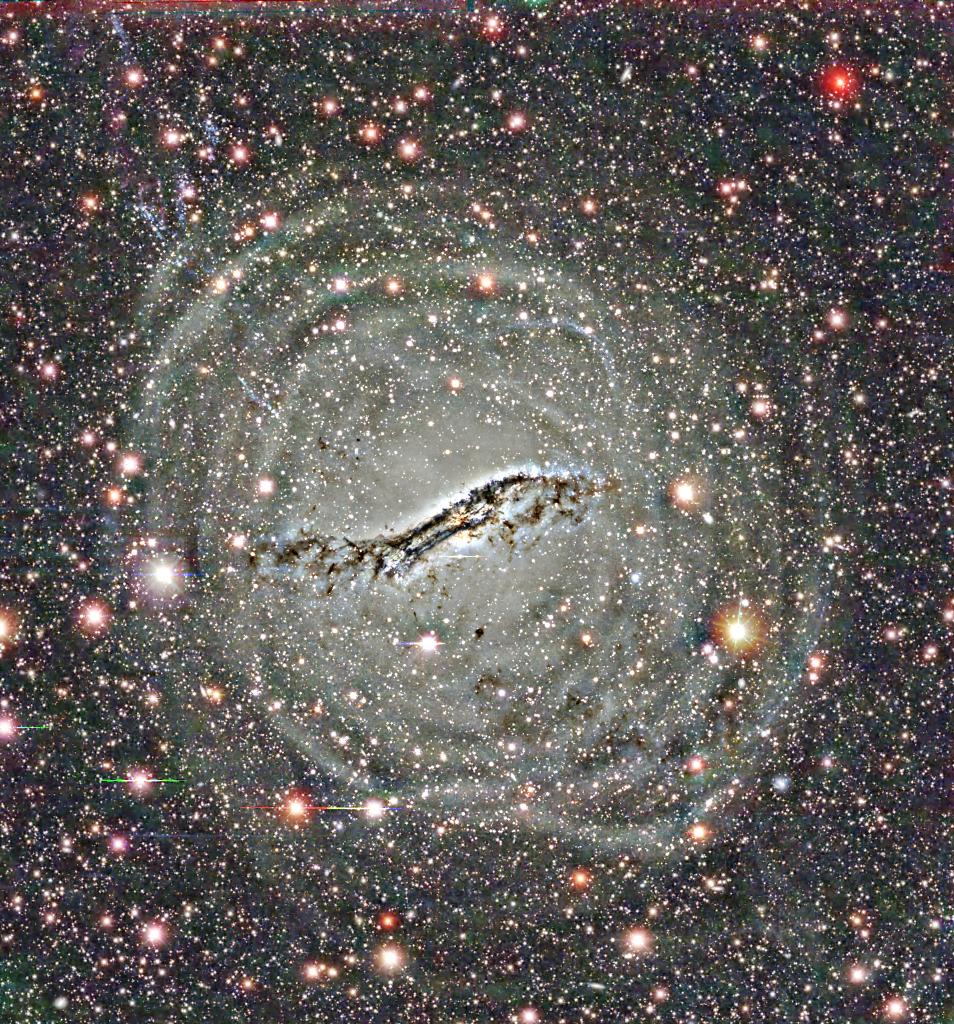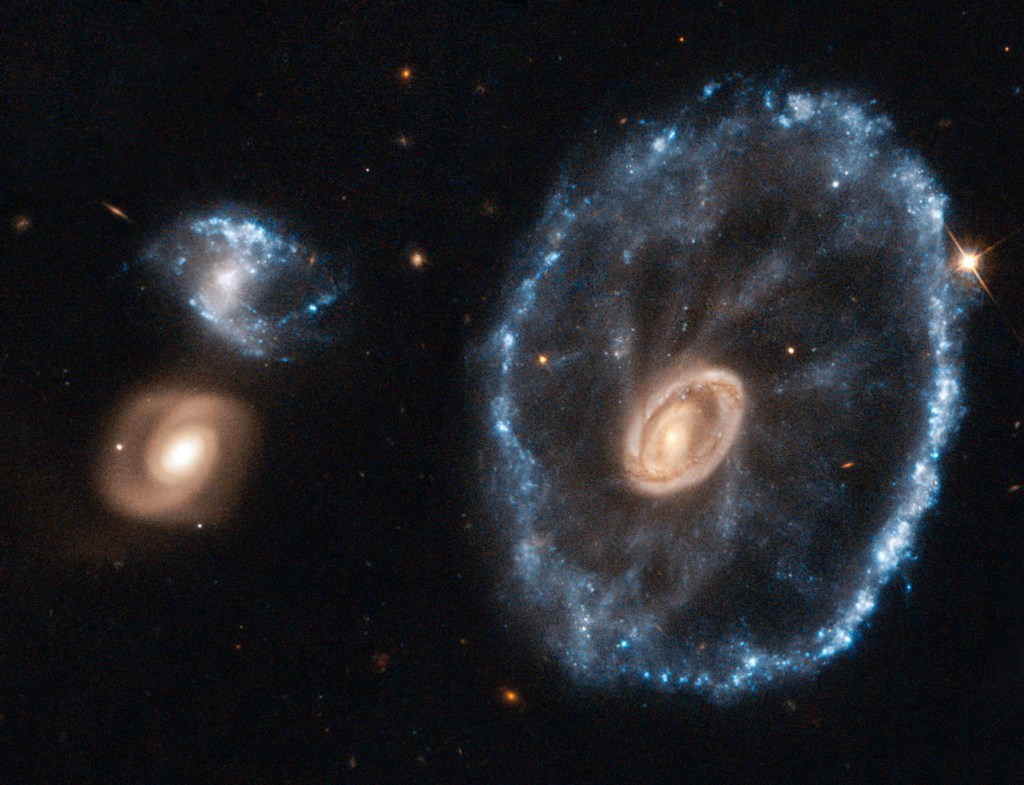
Meet the Whirlpool Galaxy, a spiral galaxy in the constellation Canes Venatici. This was actually the first galaxy to be classified as a spiral.
Specifically, the Whirlpool Galaxy is what we call a grand-design spiral: a galaxy with a very distinct pattern of two spiral arms. It was discovered by Charles Messier way back in 1773 and added to the Messier catalog as a “spiral nebula,” way back before astronomers knew what galaxies were.
But…hold on just a second.
Anybody notice there isn’t just one galaxy here?
The Whirlpool’s companion is known as NGC 5195–or, if you prefer, M51b. Together, the two galaxies are designated in the Messier catalog as M51.
We are, in fact, viewing them in the aftermath of a collision that drastically altered the shape of both galaxies. Both of these were likely once uniform disk galaxies with no spiral arms.
So, what happens when galaxies collide? And does this happen often?

It happens a lot more often than you might think.
Stars rarely ever collide; they’re just way too far apart for that, even in any one galaxy. Any two stars in a galaxy are like gnats flitting about in a football stadium. There’s very little chance of them interacting.
Galaxies, though, are more like blindfolded elephants blundering around under a circus tent.
In fact, even our home galaxy–the Milky Way–is predicted to collide with its next-door neighbor, Andromeda, in about 4.5 billion years.
I found an absolutely gorgeous timelapse of the collision:
In this simulation, we see the Milky Way and Andromeda–both initially spiral galaxies–swing close together, swing apart again, and finally merge to form one large elliptical galaxy.
Notice how, rather than colliding like a pair of semi-trucks on a freeway, it’s more like these two galaxies swing together and apart in an enormous cosmic dance. That’s because their stars don’t collide.
But their gravitational fields do.
Do me a favor and pause the video at 1:15. Notice those cloudy wisps of stars that form as the galaxies dance around one another?
These are tidal tails.

Meet the “Mice”: a pair of interacting spirals that are producing some very dramatic tidal tails.
Just as stars rarely collide within galaxies, they rarely collide even when their host galaxies collide. Instead, tidal forces force stars to alter and even break their formerly stable orbits.
In each galaxy, stars nearer to the approaching companion galaxy try to move in smaller and faster orbits; stars farther from the approaching companion try to move in larger and slower orbits.
These tides can distort galaxies…or even rip them apart.

Here’s another simulation of our galaxy colliding with Andromeda. This one doesn’t follow the collision all the way up until the merger, but it shows a lot more detail in what’s going on with individual stars.
The Milky Way is the bluer galaxy on the left, and Andromeda is the white, face-on galaxy on the right.
Notice how, as the two galaxies begin to move closer together, the tidal forces eject stars from within both galaxies.
But do me a favor and back up to 0:30, then watch from there. See the way Andromeda’s spiral arms get distorted as they pass over the Milky Way?
Yup. That’s tidal forces for ya.
Notice that, as we hit the 0:35 timestamp, the galaxies have swirled together and would be indistinguishable were it not for their blue and white color-coding in the simulation. Then we see stars begin to be ejected from the galaxies with a vengeance, almost like tossing glitter.
Then, by 0:40, the galaxies have clearly begun to move apart. But they look nothing like they once did. They’re swirling around one another in chaotic streams of stars; all that’s left of the original galaxies is their nuclei.
And speaking of galactic nuclei…

Does this image look a bit weird to you?
Meet ESO 146-5, a giant elliptical galaxy in the center of the Abell 3827 cluster in the constellation Indus (in the southern sky).
To be clear, the “single” galaxy I’m talking about is that whole hazy bright patch in the middle. Yes, the patch that’s full of not one, not two, but four distinct galactic nuclei.
Once upon a time, there were at least four separate galaxies here. We’re seeing it in an advanced stage of galactic cannibalism: the merger of galaxies to form a single, large galaxy.
And while we’re on the subject of odd elliptical galaxies…

Meet NGC 5128, an elliptical galaxy in the constellation Centaurus. It’s also known as Centaurus A and Caldwell 77.
Right away, we should notice something very peculiar about this galaxy.
It’s elliptical. But ellipticals don’t usually have thick dust clouds like that dark region you see; they’re typically round and uniform, like hazy orbs of light, with the redder, golden hues you’d expect of old galaxies.
In posts coming up very soon, we’ll explore even more peculiarities of NGC 5128. But for now, let’s enhance the contrast and take a look at one particular unique feature…

This galaxy has shells.
No, not like shells on a beach. These patterns are called “shells” for similar reasons to the “energy shells” within simplified models of the atom, or “fusion shells,” the layers of nuclear fusion that burn in aging stars. They are concentric rings or spheres.
These shells form when tides from galactic collisions distort the orbits of stars. Apparently, NGC 5128 has cannibalized at least one smaller galaxy. It may itself even be the result of a merger between two large galaxies.
And in the case of NGC 7251, a merger has resulted in a big, ol’ distorted clump of stars, with a whole spiral galaxy–albeit a small one–spinning backwards deep within.
But that’s not all a collision can do to a galaxy.

Meet the Antennae Galaxies.
These are a pair of colliding galaxies in the constellation Corvus, individually catalogued as NGC 4038/Caldwell 60 and NGC 4039/Caldwell 61.
These galaxies may not be very spiral-shaped right now, but they clearly have the dust bands that are common to spirals–and they’re absolutely ablaze with star formation.
That’s what happens when you shove together a pair of healthy spiral galaxies, rich in the star-forming material found within interstellar dust clouds.
And not only that, they have regular-ol’ spirals beat by a mile. Roughly a thousand massive star clusters have been born.
These galaxies are going crazy on the nucleosynthesis, too. Spectra reveal that the galaxies are 10-20 times richer in heavy elements than the Milky Way, indicating many, many, many generations of supernova explosions.
Last but not remotely least…meet the gorgeous Cartwheel Galaxy.

So, is that a crazy image or what?
The Cartwheel Galaxy was once either a normal spiral or a lenticular galaxy (a disk galaxy without spiral arms). Now, though, it has become a unique type of galaxy known as a ring galaxy.
This is a result of a very precisely aimed collision. Galaxies collide at random angles and trajectories, and it’s quite rare–but not unheard of–for a small galaxy to plunge through a large galaxy at high speed, almost perpendicular to the larger galaxy’s disk.
It’s like throwing a pebble into a pond. The stars and dust in the larger galaxy recoil from the impact like ripples across the surface of the water.
But such a collision will trigger intense star formation, too. This galaxy is bright at x-ray wavelengths thanks to massive stars that have already exploded, leaving behind black holes and neutron stars.
We’ve seen that galaxy interactions, collisions, and mergers are quite common. But what can this tell us about the story of galactic evolution?
We’ll answer that question coming up!